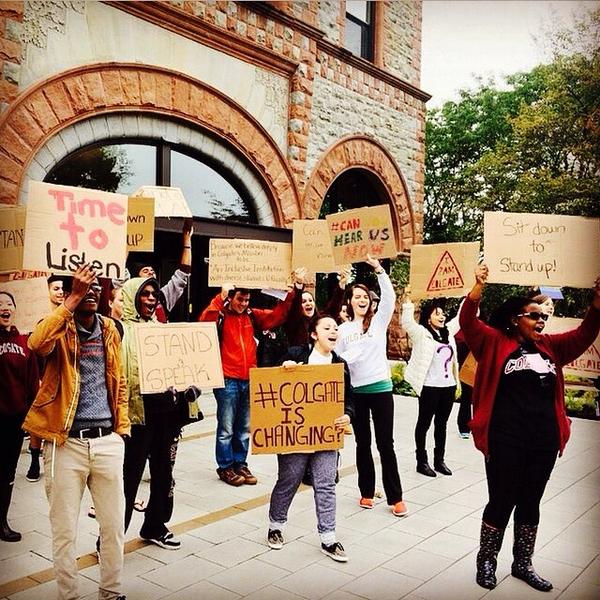Fall sends its message with splashes of red, yellow, orange and green. However, the idyllic Colgate campus has been disrupted by hundreds of students who held a sit-in for three straight days. The movement, called #Canyouhearusnow was to demonstrate against the university’s lack of diversity and to create a culture of greater inclusivity.
As a small, preppy and elite college with a dominant Greek culture and many kids whose parents fly in on private jets, diversity is not much visible. And as a minority student myself, when I enter a room, I would instinctively glance and search for non-white faces out of survival instinct.
During the three days, some of my American friends zealously slept and ate there, skipping classes with the consent of professors, while my Facebook page was overwhelmed with updates videos and likes for the protest movement.
Every morning when I finished my morning shift at the library and walked past the protest site, I witnessed how devoted my classmates are to this movement. It was after 100-hour when the school board released a 21-point road map for the future did the protest peacefully concluded. When I asked Americans about why they went there, some said that they wanted to show support, while some thought it was so cool to participate.
I personally did not go and protest because I felt this might not be an effective way to address the problem. I mean, besides the awareness raised and the pressure given to the university for institutional changes, can it help the minority feel more welcomed? Why not take more actions in real life during interaction with the minorities?
I guess it’s a cultural or ideological thing. In Western culture, when people believe in things, they want to be part of it.
However, for Asian culture where group identity is emphasized over individual values, people inevitably think more about the collective impact.
For me, the movement is a good cause and the solidarity shown is heart-warming. However, the disruptions caused were definitely big headaches for the admission staff and school board and might not achieve the intended results.
Furthermore, while many people are really concerned about the injustice and wanting to push for changes in the community, I wonder how many are just going because it is such a cool thing to show support, and how many are actually taking this chance to do some serious self-reflection about what he/she has done and can be done to become more tolerant or to make the minority feel more at home.
Frankly speaking, It’s much easier to talk and sit than doing real actions, say listening to how minorities feel and helping them out not just during this movement but also in daily life.
In fact, in psychology, there is a phenomenon called moral licensing, which is the idea that doing one good action leads one to compensate by doing fewer good actions in the future. People’s demonstration of ethical behaviour subconsciously gave them license to act unethically when the chance arose.
In one study, half the participants were asked to imagine the scenario of helping a foreign student who had difficulty in understanding a lecture. Later, these participants gave significantly less to charity than the other half of the participants, who had not been asked to imagine helping the foreign student.
So often, people are more concerned about looking good or feeling good rather than doing good, and this is amplified by social media, where you can publicly demonstrate you compassion and your sense of justice.
Institutional changes are definitely good, because they set clear benchmarks for people to behave. However, I wonder whether there will be longer-lasting behavioural changes and commitment for the cause from the student body itself.
This movement is a good start because people are paying attention to what is happening around the campus, and minorities get a chance to speak up. However, it is wrong to assume that this is the end.


